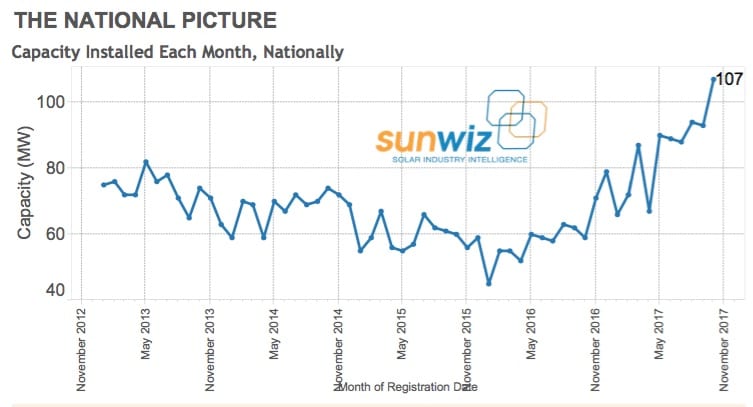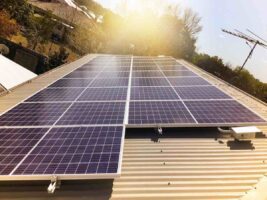Australian homes and businesses continue to install solar at an impressive clip, adding more than 100MW of rooftop PV capacity for the month of October, up from 97MW in September, and almost guaranteeing a record 1GW-plus total for the year.
In its latest monthly update, solar industry analysts SunWiz have charted another another “massive” month of small-scale solar installs, pushing the nation’s total installed PV capacity to 6.7GW, 6GW of which is made up of systems sized at 100kW and below.
According to the report, registrations in October shot up to 107MW, making it the best ever October, the fourth-highest ever level of registrations in a month, and more than double the volume of 22 months ago.
And with volumes this high, SunWiz notes, “it looks like we’re headed for the best ever Q4 AND best ever year,” with total registrations at 852MW for 2017, making the market “almost certain to eclipse 1GW of rooftop solar this year.”
One of the stars of the month for the PV market was commercial solar, with installations in the 10kW-20kW range outdone, in volume, by installs in the 75kW-plus range, as you can see in the table below.
SunWiz notes that the growth in volume occurred in every category, but was especially pronounced in the 6.3-8kW range and in the 75-100kW range.
“Volumes grew substantially in the 75+kW range, which tallied over 10 MW – 10 per cent of the volume … – which is a new record,” the report says.
“The proportion of commercial solar grew to 32 per cent, just below a previous record.”
At a state level, Queensland continues to lead PV installation rates, although followed fairly closely by New South Wales – which is having its biggest year ever – and Victoria, which SunWiz says this month captured some market share off significant growth in its commercial market, favouring systems in the 75-100kW range.
The report notes that Victoria – which last month legislated its own large-scale renewable energy target – surged to 20MW installed capacity in October, putting it 35 per cent ahead of the same time last year, and on track for its best year ever.
Western Australia “remains the state with the least commercial proportion,” the report says, and an average of 6kW/system. “But who’s complaining with record monthly volume and a year that 52 per cent ahead of any other year.”
On prices, the SunWiz notes that prices rose for smaller systems, and rose in Melbourne. But prices in Perth and Sydney hit their lowest level ever, according to data from Solar Choice. 











